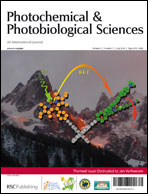A simple theoretical model is presented that describes orientation effects in electron transfer. In this model the twist and dihedral angles between electron donor (D) and acceptor (A) play a role in the distance dependence of charge transfer (CT), next to the conventional distance dependence of electron transfer that is not influenced by the angles between D and A. This can be applied to, for example, helical bridges, when twist and dihedral angles can modulate the rate. For this aim, parts are taken from the work of J. W. Verhoeven in the period 1970–1975 on dihedral angular dependence of CT interaction. Furthermore, recent work of Harriman on the effects of the twist angle on CT is used. The combination leads to a new equation that is dubbed: Karplus Relation for Charge Transfer Interaction. It can be used to describe orientation effects and non-linear plots of ln(kcs) vs. distance. This new equation is applied to two test-cases.
You have access to this article
 Please wait while we load your content...
Something went wrong. Try again?
Please wait while we load your content...
Something went wrong. Try again?


 Please wait while we load your content...
Please wait while we load your content...